Menu
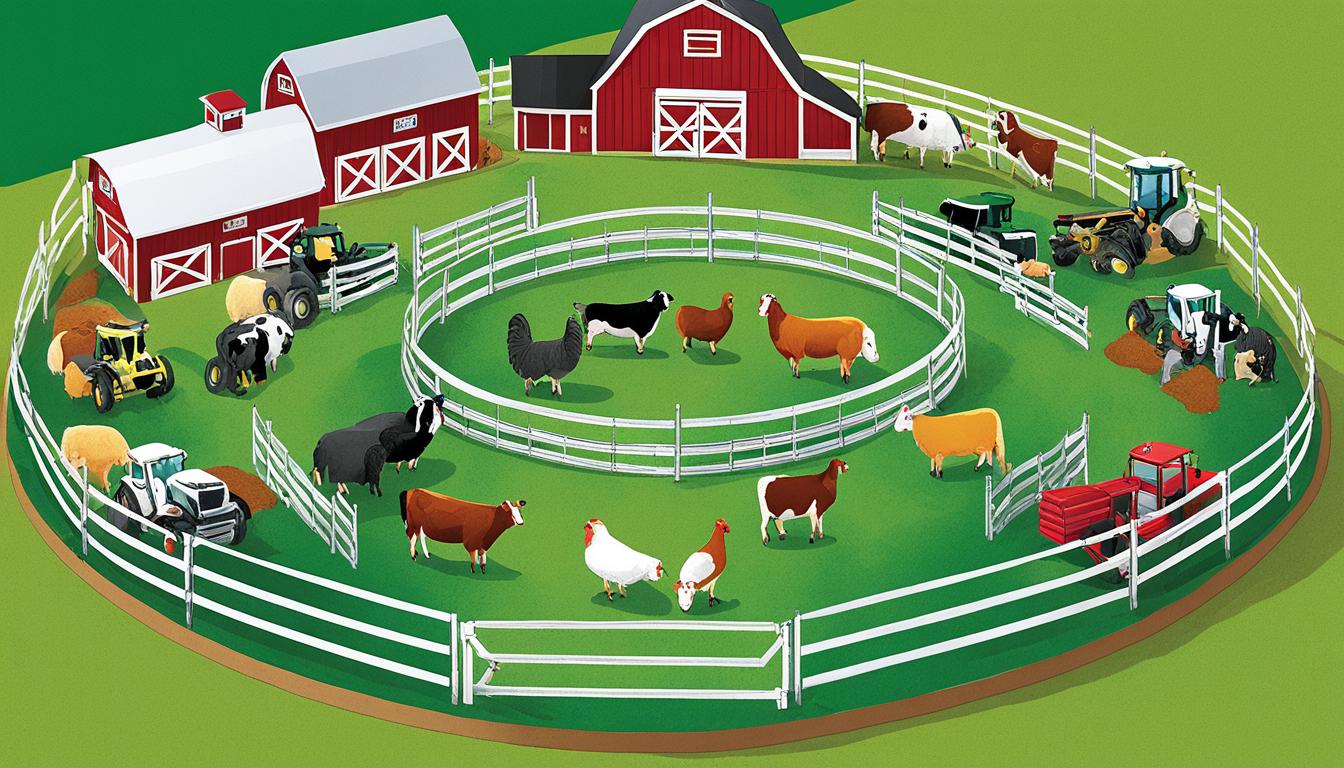
Did you know careful biosecurity can keep farmers from losing millions? It stops diseases and keeps animals healthy. This guide shows key steps to boost farm profits and keep animals well. We’ll look at steps like quarantining new animals, ensuring clean water, and farm hygiene. These help keep diseases and low productivity away.
Using strong biosecurity means more than stopping diseases; it also makes more money. It includes health checks, monitoring movements, staff training, and clean farms. These steps protect against big diseases like Avian Influenza. They make sure animals stay healthy and the farm’s finances are stable. Let’s see how these actions bring security and health to farms.
Getting to know biosecurity in the livestock industry is key. It makes sure our animals stay healthy and our farms stay productive. It includes several steps to stop diseases from spreading. This helps keep both livestock and people safe from harm.
Biosecurity steps make a big difference. They cut the risk of bacteria spreading from animals to us by 45%. This shows why we must make biosecurity part of our daily farm work.
Swiss experts on cattle and swine farms say biosecurity is vital for animal health. And it stops disease from starting. In Spain, Iberian pig farmers are keen to use biosecurity. They’re ready to spend on these steps because they see the value in them.
In Finland, pig and cattle farms strike a good balance in biosecurity use. They see the advantage of stopping diseases in their tracks. This can be done by preventing contact with wild animals, checking what we feed our animals, how we use water, and even limiting who and what comes onto the farm.
“A review on livestock production stresses the importance of mitigating risks posed by intensification, addressing challenges such as antimicrobial resistance and zoonotic diseases.”
Starting up biosecurity in livestock also means taking practical actions to protect our farms. For example, making sure vehicles used for animals are cleaned. Setting up a quarantine for new animals to stay until we check their health. Keeping the area where we store feed clean. And importantly, quick and proper disposal of dead animals. These steps help our farms stay clear of diseases. This keeps agriculture healthy and profitable.
It’s key to know how proactive steps can stop diseases from entering and spreading on farms. By following good biosecurity rules, risks of diseases decrease a lot. This keeps animals healthy, improves what they produce, and makes the farm more profitable. We will look at what biosecurity is and why it matters. We’ll also cover some important ideas.
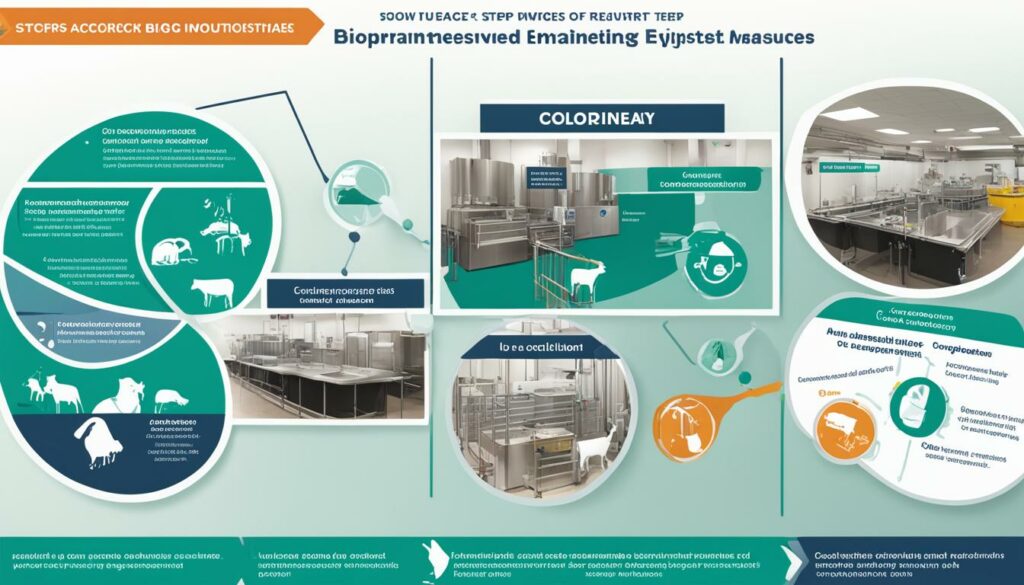
Biosecurity in livestock means taking action to keep diseases out. It’s very important for the health of our animals. Good biosecurity means we don’t need as many medical treatments which is better for everyone’s health.
It’s crucial to know how diseases move from one animal to another. This knowledge helps create strong plans to keep diseases away.
There are three main parts to good biosecurity: isolation, controlling who comes in and out, and keeping things clean. Each part plays an important role in disease prevention.
| Components | Description |
|---|---|
| Isolation | Keeping new or possibly sick animals away to stop diseases. |
| Traffic Control | Watching who comes in and out to lower the chance of diseases spreading. |
| Sanitation | Cleaning well to avoid diseases on the farm. |
In sum, understanding and using these biosecurity ideas is critical for keeping our animals safe and the farm productive.
Keeping animals healthy and stopping diseases are key for any farm to stay strong and productive. Preventative health is very important. It relies on two main strategies: routine health checks and vaccinations.
Regular health checks are vital for keeping animals well and spotting health issues early. These checks include looking at the animal, checking its vital signs, and doing tests. By doing these, farmers can find out if an animal is sick before it gets very ill. This allows them to act fast and manage the problem. It’s also important to keep a record of health care, helping to track the animal’s health.
Vaccines are very important for preventing diseases in livestock. They form a key part of their health care. Setting up a good vaccination plan can lower the chance of diseases spreading. Each animal must be vaccinated according to expert advice and what’s recommended.
Aside from vaccines, getting sick animals treated quickly is crucial. This helps stop diseases from moving to other animals. Regular visits to the vet are important. They can recommend the right treatments and keep the vaccine plans up to date.
Putting effort into routine checks and vaccinations protects the animals. It makes the farm safer and the animals healthier. This work is essential for keeping diseases away and making the farm strong against health risks.
Keeping farms clean guards our animals’ health. The key is to clean and disinfect everywhere well. This cuts down on diseases, making our farm a healthier place for animals.
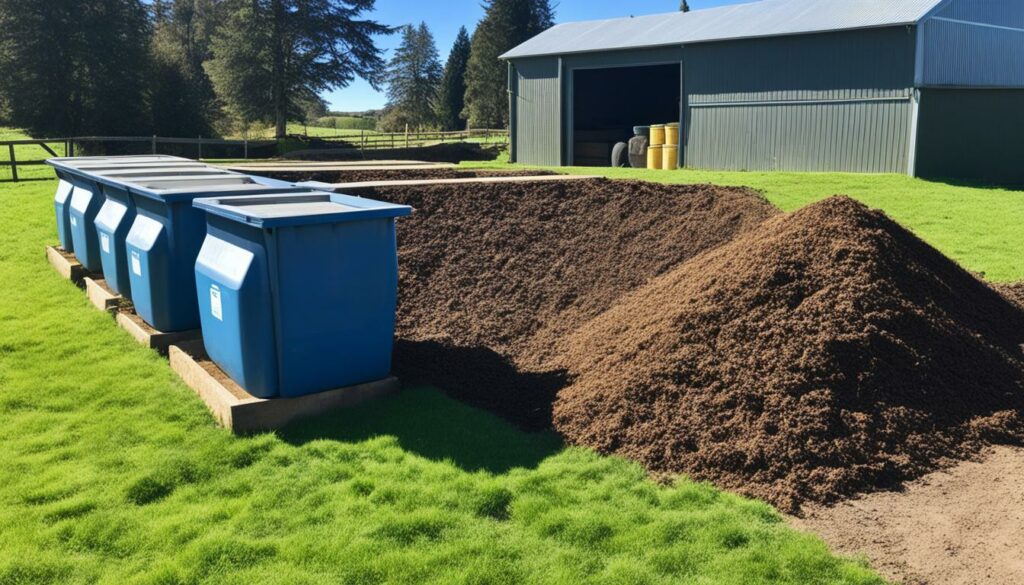
To stop disease spread, we must clean our farm well. Washing clothes with soap and bleach reduces risk by 75%. Wearing gloves during certain jobs cuts infection chances by 80%. Food safety experts advise to disinfect stuff used on sick animals before healthy ones to reduce risk by 70%. Also, cleaning feeding tools before each use drops infections by 95%.
Handling animal waste right keeps our farm clean. Storing or composting manure properly kills off 95% of harmful germs. It’s also crucial to keep farm visitors away from certain areas to avoid an 80% contamination risk. Plus, getting rid of dead animals quickly prevents diseases from spreading, cutting risk by 90%.
Good quarantine steps are key to keeping livestock healthy. When new animals come in or if some are sick, it’s vital to set up the right quarantine areas. These areas stop diseases from spreading to the rest, protecting them.
New animals usually stay in quarantine for 21-30 days before they mix with the others. This time allows for checking their health closely. It makes sure they’re not bringing any diseases that could hurt the existing animals. It is also important to keep records of where the animals go, to trace their movements.
Buying from places with strong health practices is smart when getting new animals. It’s also important to keep the farm entrance clean to lower the disease risk. Incoming animals should stay in a special area away from the main group. This is done until they pass health checks and are safe to join the others.
Sick animals must be isolated right away. This stops any illness from spreading to the healthy ones. Only use certain tools for these animals to stop disease spread.
Up to 72% of ruminant farms strictly follow steps like this. They always keep sick animals separate as part of their health rules.
An expert should handle pest control around the quarantine areas to boost safety even more. Keeping these zones clean and following health rules well strengthens the whole farm’s safety.
Good farm traffic control is key to keeping the farm safe from diseases. Controlling who and what comes onto the farm is vital. This process includes careful plans and rules to protect the health of the animals.
The first step in control farm access is to watch human and vehicle movement. It’s important to have set entry points. Also, procedures for checking everyone and everything entering the farm are essential.
To keep things safe, use vehicle disinfection stations. These stations stop harmful particles on vehicles from getting on the farm. Spraying disinfectant on tyres and undercars helps prevent the spread of diseases.
Using biosecurity disinfection stations helps to keep the farm safe. These stations can contain foot baths and dips for vehicle wheels. With regular cleaning at these points, farms can lower the risk of disease.
Many things could spread diseases on the farm. This includes wild and domestic animals, dirty feeds, and human contact. By sticking to strict disinfection routines, farmers can protect their animals’ health.

Keeping animal health in top shape and optimising production means looking after their water. It’s crucial to offer them clean, enough water. This stops harmful microbes from making the animals sick, underlining the importance of clean drinking water.
A great way to treat livestock water is with hydroxyl-based AOP technology. It uses strong oxidants to kill harmful microbes and clean the water. Using this technology doesn’t just make the water cleaner. It also helps the animals drink more water, digest food better, and take in nutrients easily.
Keeping water clean for animals is vital. Apart from hydroxyl-based AOP, it’s key to clean water tanks and troughs often. Mixing water from different sources can help too. This all reduces the risk of the animals getting sick from dirty water.
Clean water is especially important in caring for livestock. The outbreak of Avian Influenza (AI) shows how bad water can affect an entire industry. Dirty water is perfect for harmful microbes to grow. This makes regular cleaning and giving animals fresh water a must. It helps keep diseases away, promotes health, and boosts growth in the animals.
Great water management, like using hydroxyl-based AOP, is fundamental on farms. It protects animal health and helps farms run well. Keeping a close eye on biosecurity plans and updating them is also important. This considers any changes on the farm and new risks, to keep livestock management standards high.
Keeping livestock healthy and free from diseases is key. This involves getting feed from trusted sources. It also means acting quickly when there’s a feed spill. These steps help ensure that animals eat well and don’t face harmful substances.
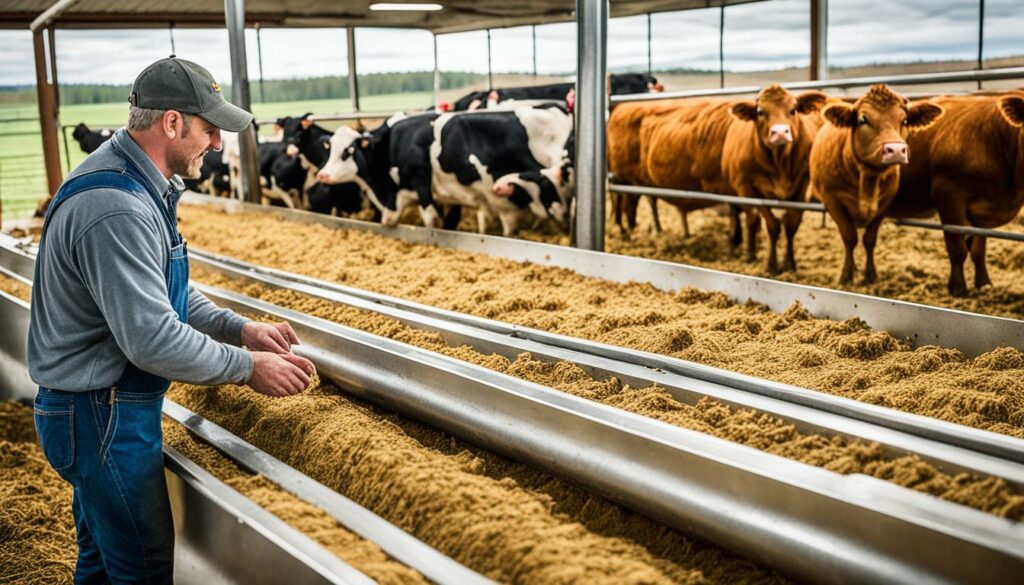
Storing feed safely is also very important. It keeps away animals and bugs that might spoil the feed. Making sure the storage area is clean and dry cuts down on contamination risks. Good storage helps to maintain the feed’s quality.
Studies from places like Switzerland, Spain, Argentina, and Germany show that careful feed management works. It’s linked to better farm results and fewer sicknesses. Making sure only safe feed enters a farm is a top concern for its health and quality.
| Country | Key Findings |
|---|---|
| Switzerland | Importance of on-farm biosecurity practices for cattle and swine farms. |
| Spain | Attitudes towards biosecurity measures and investment in Iberian pig farms. |
| Finland | Farm characteristics and perceptions influencing biosecurity adoption. |
| Germany | Associations between antimicrobial usage, biosecurity measures, and farm performance. |
Controlling feed quality involves safe handling from start to finish. This means choosing the best ingredients and stopping contamination during processing. A strong quality control system and safe storage are crucial. They lead to healthier livestock and better farm practices overall.
Being successful with biosecurity starts with a clear plan that looks at different parts of farm life. It’s very important to teach all farm workers about the rules of biosecurity. It’s also key to keep training them regularly. This way, everyone learns about new ways to stop the spread of diseases.
Having good ways to watch health and infections is also crucial. By checking often, farms can spot problems early and act fast. Knowing where animals have been helps stop diseases from spreading. So, keeping careful track of their movements is a big part of biosecurity.
Keeping animals still matters a lot. Making rules for when animals have to stay alone, like when they’re bought new or when they’re sick, helps a lot. It lowers the chances of sickness spreading. Cleaning vehicles that come onto the farm well is another way to keep out germs.
Getting rid of dead animals right is key. This stops wild animals and rats from bringing diseases to the farm. And, regularly cleaning up animal waste is crucial for stopping diseases from spreading.
Planning for emergencies is also very important in biosecurity. Farm plans should be able to change to keep up with new knowledge or farm activities. This flexibility is important for staying safe.
| Country | Findings |
|---|---|
| Switzerland | Effectiveness of biosecurity protocols for cattle and swine farms, Kuster et al. (2015) |
| Spain | Farmers’ attitudes towards biosecurity measures in Iberian pig farms, Horrillo et al. (2022) |
| Finland | Impact of farm characteristics and cost perceptions on biosecurity adoption, Niemi et al. (2016) |
| Sweden | Assessment of biosecurity levels and health practices in farrow-to-finish herds, Backhans et al. (2015) |
By following these biosecurity steps well, risks can be lowered. This helps keep animals healthy. And, it supports the success of livestock farms.
Keeping livestock healthy and farms productive is key. We must know about and deal with common animal diseases. This helps us keep our animals safe and working well.
Bacteria, viruses, and parasites are major risks to animals. Some diseases like foot-and-mouth and Q fever spread in the air. Others, like Hendra and Nipah, come from eating or drinking contaminated food or water.
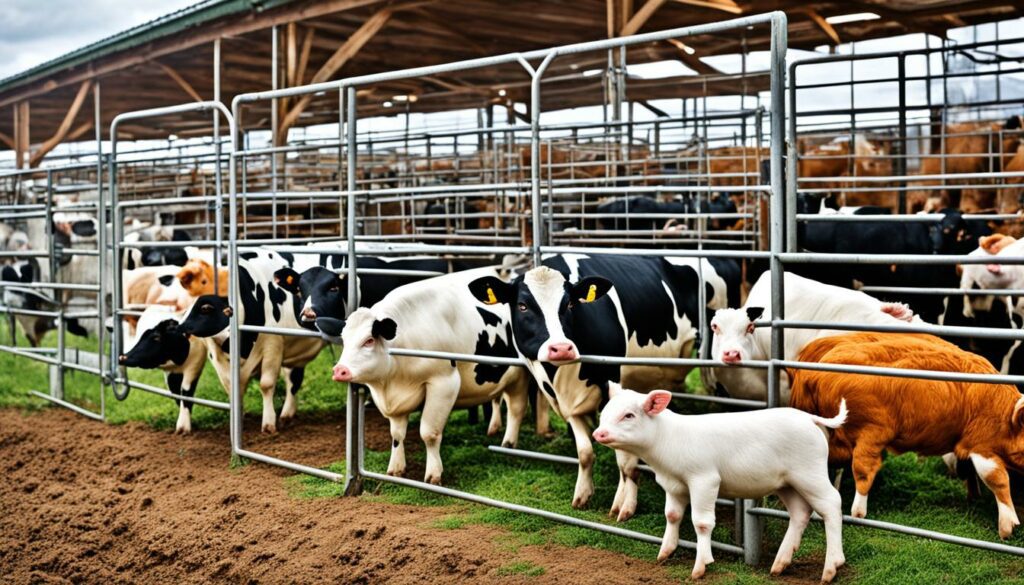
Animals can also get sick from touching each other. This spreads diseases like African swine fever. Even things like clothes and equipment can carry these germs. Insects, like fleas, ticks, and mosquitoes, can also pass on diseases.
Making farms safer with biosecurity helps a lot. Studies in places like Switzerland show this works for cows and pigs. How clean a farm is and the owner’s attitude can affect this.
Good control strategies include:
To fight off animal diseases, use quarantine, good cleaning, and careful manure handling. These steps keep your animals safe and your farm healthy. They’re a smart long-term plan for safety on your farm.
| Biosecurity Measure | Effectiveness |
|---|---|
| Quarantine of New Animals | High |
| Regular Sanitation | High |
| Manure Management | Medium |
| Source of Animals | High |
Veterinarians are key in keeping farms safe from diseases. They provide vital services to protect animal health and keep agriculture sustainable. These services include checking, diagnosing, and stopping diseases in farm animals.
Veterinarians play a big role in keeping farms safe. They give advice on health that fits each farm’s needs. This advice covers preventing diseases, the right vaccinations, and good food for the animals. Vets also find and treat illnesses early, stopping them from spreading.
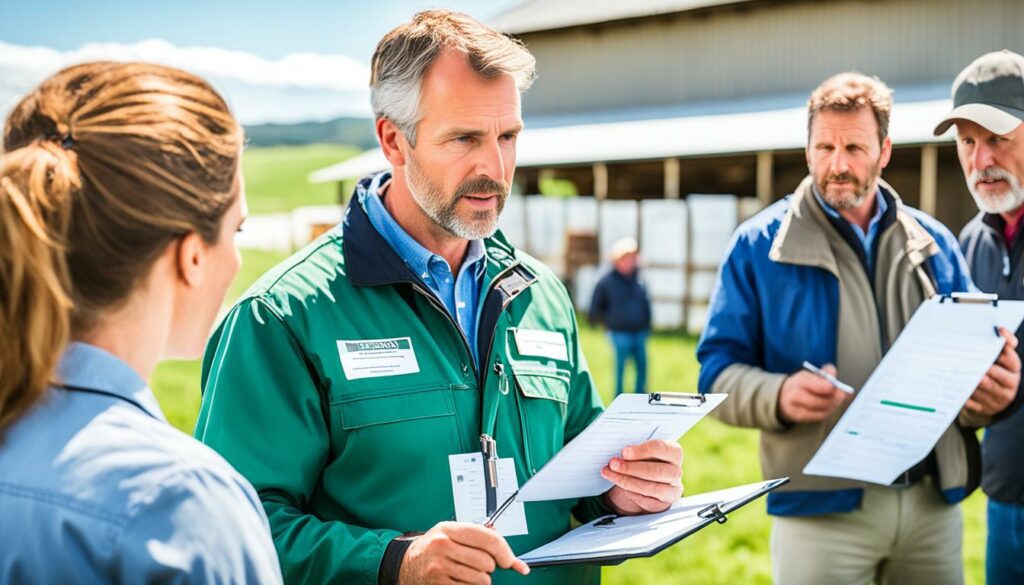
Having veterinarians check on the animals regularly is crucial. These check-ups find and fix health issues before they become big problems. Services like monitoring, diagnosing, and checking health are vital for keeping animals healthy and productive. The information from these checks helps create specific biosecurity plans. Such plans are very effective, as seen in studies from Switzerland and EU countries.
Professional veterinary biosecurity help keeps farms safe and meets rules. For example, Spanish pig farms need vets and farmers to work together constantly. This teamwork ensures diseases are prevented well.
On-farm biosecurity measures for cattle and swine farms are seen as key by experts.
Using vets’ knowledge, farms can set up solid biosecurity plans. This helps keep animals healthy and productive. It also protects public health from diseases that can spread from animals to people.
Top-notch livestock management is key for animal welfare and work output. By using strict biosecurity and the best care methods, we cut the chances of diseases. About 71% of illnesses in animals come from not keeping things clean enough. This shows how crucial it is to be very careful. Good management, which includes keeping things clean and checking animal health often, boosts how well animals are doing.
Most farms and ranches, around 83%, take steps to keep their animals healthy. They isolate new animals and properly get rid of dead ones. Doing this lowers the number of sick animals and makes sure fewer animals die.
About 62% of the time, not cleaning equipment well causes issues on farms. This shows why it’s vital to be very thorough when we clean. Proper waste disposal, controlling pests, and giving animals good food are big parts of managing livestock. Mixing these with regular checks done by vets and following biosecurity rules makes a farm do well. In the end, very careful management and hygiene keep animals well, making farming both successful and lasting.
Livestock biosecurity measures aim to keep infectious diseases out of farms. They use quarantine, cleaning, and managing who enters the farm as protection.
Biosecurity keeps animals healthy and stops diseases from spreading. It saves money by reducing vet bills and helps make more profit.
To stop diseases, keep new animals away, keep the farm clean, check water and food, limit who can enter, and vaccinate regularly.
Checking animals’ health often is key. It finds and treats diseases early. This stops infections and keeps all animals well.
Vaccines are critical in keeping diseases away. They protect animals, reducing the risk of diseases spreading.
Good hygiene means cleaning animal homes and tools often. Properly getting rid of waste and keeping things clean helps stop germs.
New animals should stay far from the main group for a while. A vet decides how long. This stops diseases from starting.
Sick animals need their space and special care to stop diseases spreading. They should have separate tools and the right medicine.
We control who and what comes onto the farm with rules. Things like footbaths and checks for vehicles stop diseases from entering.
Using advanced water treatments, like AOP, ensures animals drink safe water. This keeps them healthy and productive.
Healthy animals need clean water. It helps prevent diseases and keeps their digestion and health strong, making the farm better.
Choose food carefully, keep it clean, and protect it from wild animals. This stops diseases from getting to animals through food.
Biosecurity protocols stop disease spread, keep animals healthy, and help farms do well. They follow the law and protect livestock health well.
Germs like bacteria, viruses, and parasites can hurt animals. They come from dirty food or water, equipment, and contact with people and animals.
To fight these germs, use vaccines, keep everything clean, and watch over water and food. Make sure new animals are healthy and control who comes and goes.
Vets are very important for farm health. They advise on keeping animals safe and healthy. They also help with vaccinations and sickness checks.
Techniques that protect animals also keep diseases away. They help animals be productive and stay healthy, aiding in the care of the farm.